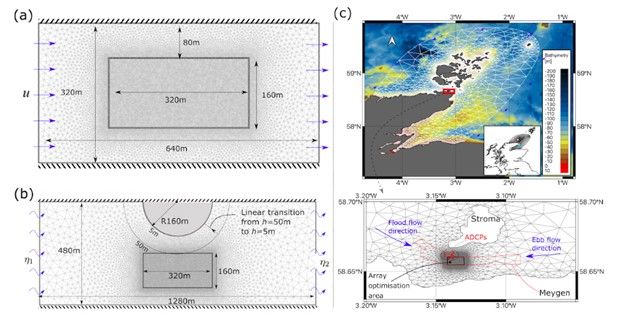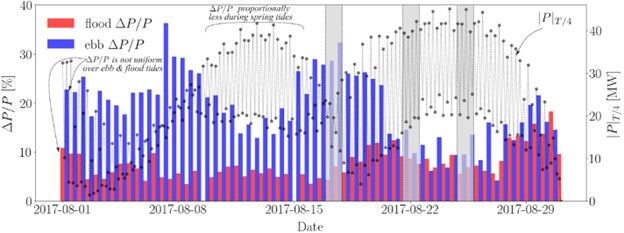Study on Tidal Array Spatial Optimisation Presented by Iliad at IAHR Congress
July 27th, 2022
H20, one of the most recognised chemical symbols, can either help or hurt. In the context of the ocean, tidal energy has the ability to be converted into power and provide electricity. Who knew?
In order for this to happen a multitude of complex digital analytics take place. The EU-funded Iliad Project, which includes 56 international partners, replicates virtual sea patterns, past, present and future. Aptly christened as digital twin technology, the ability to model sea behaviour, observe it with analytics and other computing, means that Iliad will provide highly accurate predictions and ensure a healthy sea economy.
To this end, the (IAHR) International Association for Hydro-environment Engineering and Research held their 39th biennial World Congress in Spain, from June 20th to 24th, 2022. Their raison d'etre – to bring researchers and professionals together to share insights, identify emerging technology trends and address ongoing environmental challenges. Their theme this year, 'From Snow to Sea' was chosen to highlight the importance of considering the integral water cycle to address present and future challenges.
Representing Iliad at the IAHR Congress was Dr Athanasios Angeloudis, (School of Engineering, Institute for Infrastructure & Environment, University of Edinburgh, Edinburgh, UK). Dr Angeloudis delivered an address entitled: Tidal Array Spatial Optimisation combining Shallow Water Equations and wake superposition modelling.
Within UK waters, it is estimated that tidal stream energy alone could provide 11 percent of the current annual electricity demand. Stakeholders take note; in optimising tidal array layouts, one of the benefits includes reductions in investment uncertainty.
Dr Angeloudis explained, “Defining complex, high-energy tidal hydrodynamics with an optimal array layout is challenging and remains an active research area.” He and his team at the University of Edinburgh (Mr Connor Jordan, Ms Anastasia Fragkou) brought together researchers from US’s NREL (Dr Georgios Deskos), Imperial College London (Mr Davor Dundovic, Prof Matthew Piggott) and the University of Plymouth (Dr Daniel Coles) to work on an optimisation approach combining an analytical-based wake model inspired from the more mature wind energy industry, FLORIS, with a coastal ocean hydrodynamics model, Thetis.
The objective was to use techniques to achieve turbine array optimisation at a fraction of the computational cost of alternative methods. A customised algorithm was designed using a shallow water equation model. This turbine layout optimisation process was able to deliver an array design that is 12% more productive on average than a staggered layout.
The study also addressed the layout optimisation problem focusing on an array optimisation strategy that is both computationally efficient and has multi-objective optimisation settings. In order to maintain an optimal array design and performance, Dr Angeloudis stressed that the design needs to be reliable and accurate taking into consideration important hydrodynamic factors and turbine characteristics.
The FLORIS model (from the US National Renewable Energy Laboratory) in conjunction with Thetis progressed to a practical study of the Inner Sound of the Pentland Firth, UK.

The methodology was applied to:
- Demonstrate potential in arrays of growing numbers.
- Exhibit the potential to deliver substantially improved tidal array layouts.
The result in the Inner Sound of the Pentland Firth showed: an overall improvement in power output in the order of 12% for 3D minimum device spacing (where D is the turbine rotor diameter) and up to almost 16% when reduced to 1.5D. These results are particularly timely, given the recent news of Meygen Phase 2 winning their bid in UK’s Contract for Difference (CfD) Round 4, which will extend the current 4-device array that is managed by Meygen Ltd at the case study site.
The study also demonstrated the ineffectiveness of staggered arrangements, which can be overcome through the computationally efficient application of this methodology for complex geometries and flow dynamics.

Lastly, this study indicated that flow asymmetry in conjunction with minimum distance requirements may render the exploitation of local blockage effects rather challenging. Studies using 24 and then 48 turbines at Pentland Firth indicated low levels of global blockage. However, as the number of turbines doubled to 48, blockage effects became more noticeable, an element that is further explored.
In conclusion, this technology can save time and money by modelling changes, testing components or systems function, and troubleshooting malfunctions inexpensively in a virtual world.

